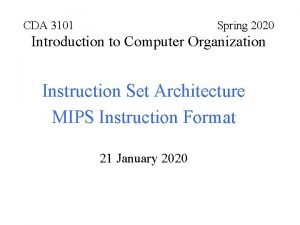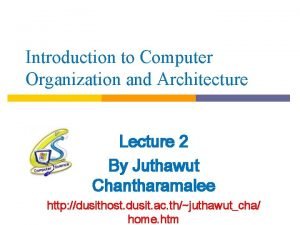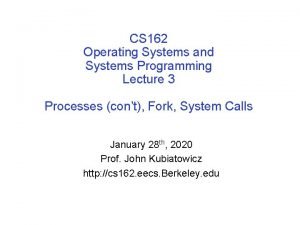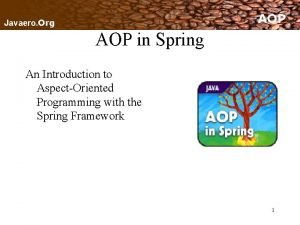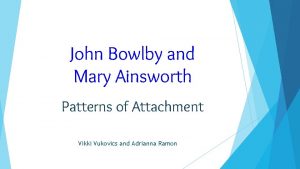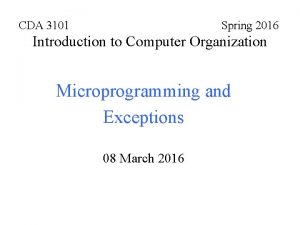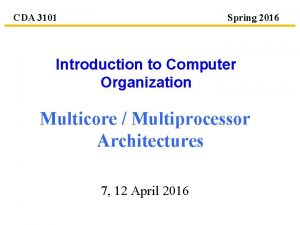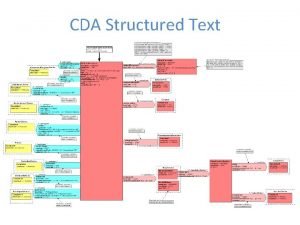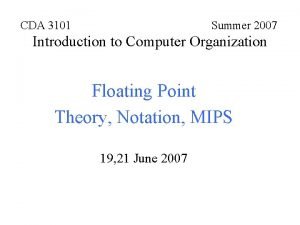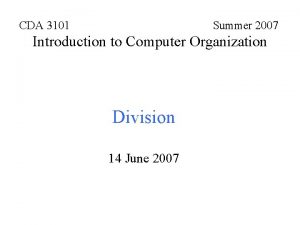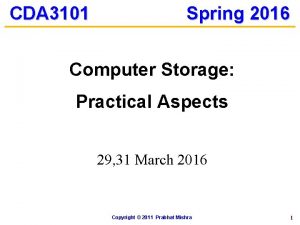CDA 3101 Spring 2020 Introduction to Computer Organization































- Slides: 31

CDA 3101 Spring 2020 Introduction to Computer Organization The Arithmetic Logic Unit (ALU) and MIPS ALU Support 06, 11 February 2020

Overview • • • Hardware building blocks ALU design ALU implementation 1 -bit ALU 32 -bit ALU

Hardware Building Blocks • ALUs are implemented using lower level components (logic gates) • Gate (review) – Hardware element that receives a certain number of inputs and produces one output – Can be represented as a truth table or logic equation – Gates in turn are implemented with transistors • ALU Building Blocks (review) – – And gate Or gate Inverter (not gate) Multiplexor (mux)

Basic Gates

Modular ALU Design • Facts – Building blocks work with individual (I/O) bits – ALU works with 32 -bit registers – ALU performs a variety of tasks (+, -, *, /, shift, etc) • Principles – – Build 32 separate 1 -bit ALUs Build separate hardware blocks for each task Perform all operations in parallel Use a mux to choose the actual operation (make decision) • Advantages – Easy to add new operations (instructions) • Add new data lines into the muxes; inform “control” of the change.

ALU Implementation Control lines (n) Data lines (2 n) Output: one per mux 1. 32 -bit ALU uses 32 muxes (one for each output bit) 2. Go through instruction set and add data (and control) lines to implement the corresponding operations.

One-Bit Logical Instructions • Map directly onto hardware components – AND instruction • One of data lines should be a simple AND gate – OR instruction • Another data line should be a simple OR gate Op (control) A B 0 1 Definition Op C 0 1 C A and B A or B

One-Bit Full Adder A: B: + Sum: . . . (0). . . 0 (1) (0) (0) 0 0 (0)1 1 1 (1)0 0 1 (0)1 1 0 (0)1 Carry. Out • Each bit of addition has – Three input bits: Ai, Bi, Carry. Ini – Two output bits: Sumi, Carry. Outi ( Carry. Ini+1 = Carry. Outi ) Carry. In Inputs Outputs

Full Adder’s Truth Table Symbol Carry. In A B + Carry. Out Sum A 0 0 1 1 B 0 0 1 1 Definition Carry. In Carry. Out Sum 0 0 0 1 1 1 0 0 1 1 1 Carry. Out = (A’*B*Carry. In) + (A*B’*Carry. In) + (A*B*Carry. In’) + (A*B*Carry. In) = (B*Carry. In) + (A*B) Sum = (A’*B’*Carry. In) + (A’*B*Carry. In’) + (A*B’*Carry. In’) + (A*B*Carry. In)

Full Adder Circuit (1/2) 1. Construct the gates for Sum 2. Implement the gates for Carry. Out 3. Connect all inputs with the same name

Full Adder Circuit (2/2)

One-Bit ALU Least significant bit Other bits

32 -Bit ALU Binvert Operation a 0 Result 0 b 0 a 1 Result 1 b 1 . . . a 31 b 31 Result 31

Summary • Building blocks: basic gates (AND, OR, NOT) • Modular design and implementation – Gates have multiple inputs and one output – ALU works with 32 -bit words (integers) – ALU implements a variety of operations in parallel => Construct first a 1 -bit ALU – Mux chooses one of many different ALU operations – From the architecture’s instruction set, add the basic ALU operations necessary to implement that instruction – Two’s complement representation allows the use of the same hardware for both addition and subtraction

Anticipate the Weekend!!

Application to MIPS ALU • • MIPS ALU extensions Overflow detection Slt instruction Branch instructions Shift instructions Immediate instructions ALU performance – Performance vs. cost – Carry lookahead adder • Implementation alternatives

Recall: Generic One-Bit ALU 0 – ADD 1 – SUB 00 – AND 01 – OR 10 – ADD AND OR Other bits First bit (LSB) Operations: AND, OR, ADD, SUB Mux Control: 000 001 010 110

Slt Instruction • Slt rd, rs, rt rd: 0000 0000 000 r • 1 if (rs < rt) 0 else A < B => A – B < 0 1. Perform subtraction using full adder 2. Check highest-order bit (sign bit) 3. Sign bit tells us whether A < B • • • New input line (Less) goes directly to mux New control line (111) for slt Result for slt is not the output from ALU – Need a new 1 -bit ALU for the most significant bit • • It has a new output line (Set) used only for slt (Overflow detection logic is also associated with this bit)

Slt Support First bit (LSB) Sign bit

Branch Instructions • beq $t 5, $t 6, L – Use subtraction: (a-b) = 0 implies a = b – Add hardware to test if the result is 0 – OR all 32 results and invert the OR output Zero = (Result 1 + Result 2 +. . + Result 31) • Consider A + B – Overflow if • A=0? • B=0? and A - B

Branch Support 1 (A = B) 0 otherwise

Shift instructions • SLL, SRL, and SRA • We need a data line for a shifter (L and R) • However, shifters are much more easily implemented at the transistor level (outside the ALU) • Barrel shifters x 3 x 2 x 1 x 0 Diagonal closed switch pattern controlled by the control unit x 3 x 2 x 1 x 0 Output, x x 2 x 1 x 0 0 Output, x<<1 0 x 3 x 2 x 1 Output, x>>1

Immediate Instructions • First input to ALU is the first register (rs) • Second input – Data from register (rt) – Zero- or sing-extended immediate • Add a mux at second input of ALU Registers rs 32 rt 0 Sign extend 16 1 IR: Control Unit ALU Result Zero Overflow Memory address

ALU Performance • Is a 32 -bit ALU as fast as a 1 -bit ALU? – Can you see the ripple? • Hardware executes in parallel • Speed vs. Cost – Fewer sequential gates vs. number of gates • Two extremes to do addition – Ripple carry and sum-of-products • How could you get rid of the ripple – Two levels of logic c 1 = b 0 c 0 + a 0 c 0 c 2 = b 1 c 1 + a 1 c 1 c 3 = b 2 c 2 + a 2 c 2 c 4 = b 3 c 3 + a 3 c 3 + + a 0 b 0 a 1 b 1 a 2 b 2 a 3 b 3 c 2 = c 3 = c 4 =

Carry-Lookahead Adder (1/2) • An approach in-between our two extremes • Motivation: – If we didn't know the value of carry-in, what could we do? – When would we always generate a carry? gi = ai bi – When would we propagate the carry? pi = a i + b i • Did we get rid of the ripple? c 1 = g 0 + p 0 c 0 c 2 = g 1 + p 1 c 1 c 2 = g 1 + p 1 g 0 + p 1 p 0 c 0 c 3 = g 2 + p 2 c 2 c 3 = c 4 = g 3 + p 3 c 3 c 4 =

Carry-Lookahead Adder (2/2) • Can’t build a 16 bit adder this way. . . (too big) • Could use ripple carry of 4 -bit CLA adders • Better: use the CLA principle again!

Second Level P and G

Ripple Carry vs. Carry Lookahead • • Assume each gate (AND or OR) takes the same time Total time = number of gates of longest path Consider 16 -bit adders Carry. Out signals c 16 and C 4 define the longest path – Ripple carry: 2 * 16 = 32 – Carry lookahead: 2 + 1 = 5 • • 2 levels of logic in terms of Pi and Gi Pi is specified in one level of logic (AND) using pi Gi is specified in two levels of logic using pi and gi are each one level of logic in terms of ai and bi • A carry lookahead adder is six times faster

Implementation Alternatives • The logic equation for the sum output can be expressed more simply with XOR gates Sum = a XOR b XOR Carry. In • In some technologies, XOR is more efficient than two levels of AND and OR • Processors are designed now in CMOS transistors (switches) • CMOS ALU and barrel shifters have many fewer multiplexors than shown in our design • However, the design principles are similar

Conclusions • We can build an ALU to support the MIPS ISA – Key Idea: Use multiplexer to select ALU output – Subtraction uses two’s complement addition – Replicate 1 -bit ALU to produce 32 -bit ALU • Important points about hardware – All of the gates in the ALU work in parallel – The speed of a gate is affected by the number of inputs – Speed of a circuit is affected by the number of gates in series (on the critical path or the deepest level of logic) • Our primary focus: (conceptual) – Clever changes to organization can improve performance (similar to using better algorithms in software)

Enjoy the Weekend & Next Week!!
 Cda 3101
Cda 3101 Cda3101 uf
Cda3101 uf Cda 3101
Cda 3101 Cda3101
Cda3101 Process organization in computer organization
Process organization in computer organization Seg 3101
Seg 3101 Seg 3101
Seg 3101 Seg 3101
Seg 3101 Seg 3101
Seg 3101 Seg 3101
Seg 3101 Eecs yorku email
Eecs yorku email Seg 3101
Seg 3101 Spring, summer, fall, winter... and spring (2003)
Spring, summer, fall, winter... and spring (2003) Spring summer winter fall
Spring summer winter fall Basic structure of computer in computer organization
Basic structure of computer in computer organization Architecture and organization difference
Architecture and organization difference Interrupt cycle flow chart
Interrupt cycle flow chart Fgi and fgo in computer architecture
Fgi and fgo in computer architecture Introduction to computer organization and architecture
Introduction to computer organization and architecture Introduction to computer organization
Introduction to computer organization Spring io conference 2020
Spring io conference 2020 Math enrichment spring 2020
Math enrichment spring 2020 Cs162 spring 2020
Cs162 spring 2020 Organization by point
Organization by point Spring introduction
Spring introduction Spring boot aspect example
Spring boot aspect example Repetititon
Repetititon Cda competency statement 1
Cda competency statement 1 Mary shelley cda
Mary shelley cda Kate cda
Kate cda Pacific rim2 cda
Pacific rim2 cda Charlie chaplin cda
Charlie chaplin cda



